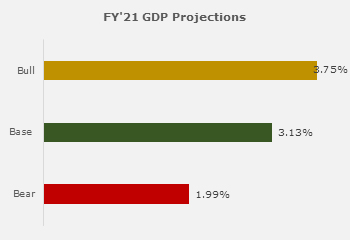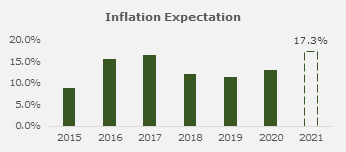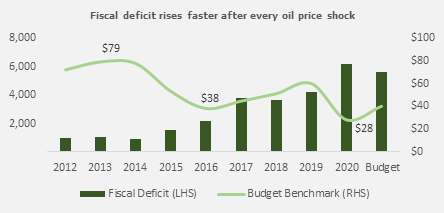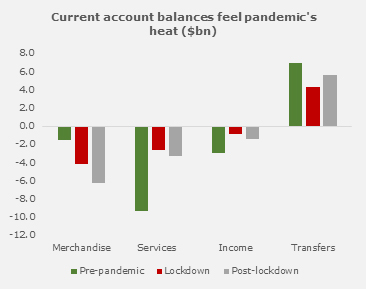On the Cusp of Recovery.

Recently, the Research Desk of Vetiva Capital Management Limited released its Macroeconomic Outlook for H2’21,
titled On the cusp of recovery.
Below is a summary of our outlook for Nigeria:
Ascending from pandemic depths
On the back of a favourable base year, the Nigerian economy is expected to rebound strongly by 3.13% y/y in 2021.
Given the accommodative monetary policy environment, zero likelihood of lockdowns, and easing of OPEC+ production cuts,
Nigeria could record a strong one-off recovery in the current year.
Agriculture could ride on the interventions of the Central Bank to sustain its resilient growth outcomes.
However, headwinds from herder-farmer clashes could limit the pace of growth. The manufacturing sector could also maintain
its expansion path as COVID-19 restrictions on labour hours are non-existent and innovative marketing strategies
are deployed to cater to depressed consumer wallets.

Source: NBS, Vetiva Research
The oil sector could experience a breather from
the gradual easing of OPEC+ production cuts.
However, headwinds could arise from the
return of shale producers and the
introduction of more OPEC+ production cuts,
should severe waves of the virus arise, or the Iranian nuclear deal pulls through.
We look forward to
slower growth in the financial services and ICT sectors due to business climate hostilities
and NIN-SIM linkage restrictions, respectively. High contact industries in the services sector could recover slowly
on the back of restoration of supply chains, reopening of the borders, amid slow adaptation to the post-lockdown era.
Inflation: Base effects versus Reforms
We see base effects subduing inflationary pressures in H2’21 as food pricing pressures ease as we approach the harvest season.
However, there is room for more uptick in core inflation, should there be fuel subsidy removal upon assent to the PIB.
Thus, we expect inflation to rise to 17.34% in 2021 (FY’20: 13.21%).

Source: NBS, Vetiva Research
Given our base case assumption of moderation in inflation, we expect the
CBN to lay its monetary policy tools on the table
as the Bank allows its expansionary policies to permeate the economy. Thus, we expect the
Monetary Policy Rate to remain frozen at 11.5%.
Fiscal Policy: In a bundle of dilemmas
Historical evidence shows that fiscal deficit rises quicker during an oil price shock before a subsequent slowdown.
However, due to the resurfacing of fuel subsidies, Nigeria could record a higher fiscal deficit in 2021 as COVID-19
holds back export demand while subsidies buoy expenditure obligations.
According to our estimates, more is being spent on subsidies than is remitted to the states.
With the upsurge in oil prices, Federation Accounts Allocation inflows could be the opportunity cost
of fuel subsidy maintenance. While this could change with the full removal of fuel subsidies
upon assent to the Petroleum Industry Bill (PIB), social resistance to reforms could spring up.
As Nigeria repays some of its external loans,
the debt stock has receded slightly from 2020 levels.
While
multilateral debt has dominated our external debt stock mix, commercial debt is on the rise stoking
our
debt service-to-revenue ratio. The
Debt Management Office has rolled out its
medium-term debt strategy,
which raises the debt ceiling to
40% of GDP and prioritizes domestic debt over external debt (70:30).
External Sector: A déjà vu scenario
Despite higher oil prices, the discovery of the infectious Delta variant held back crude demand in India.
Thus, the merchandise trade deficit has deepened since the pandemic struck. Due to increased
travel requirements and the proliferation of virtual meeting platforms, the services deficit has moderated.
The deficit in the income segment has moderated due to unattractive yields in
the fixed income market and currency overvaluation. The surplus in the transfers
segment has been upheld by remittance flows, yet they remain shy of pre-pandemic levels.
Going forward, while we expect a recovery in export demand, the reopening of the borders could
increase the import bill as previously smuggled goods make way through the borders, resulting in a wider
merchandise trade deficit. A pick-up in travel and tourism could expand the deficit in the services segment.
The income segment could record a facelift from exchange rate unification efforts over the medium term.
The Naira has witnessed
twists and turns over the years. With every
oil price shock comes an adjustment in
the currency peg.
When oil prices recover, the Naira never does, as these shocks correct the
pre-existing overvaluation of the currency.
Unless
exports are diversified and
imports are substituted with local production, the Naira could continually be
strained by
downcycles and
commodity price shocks.
We expect
oil prices to average $64 - $66 in the second half of the year. Despite the plunge in the
external reserves,
we expect the proposed
Eurobond raise to lift
reserves to
$34.1 billion by the end of the year. We see the NAFEX rate
fluctuating
between N411/$ - ₦414/$ while the parallel market is expected to average
₦496/$ - ₦499 in H2’21.
Should the country take advantage of the increased
Special Drawing Rights (SDR) allocation, we could see
considerable
accretion in reserves and
appreciation in the Naira.




